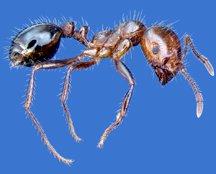National Invasive Species Awareness Week: March 3rd – March 8th
March 8th: Red Imported Fire Ant (Solenopsis invicta Buren) & Giant Tiger Prawn (Penaeus monodon):
Red Imported Fire Ant: Many of us cherish childhood memories of family picnics during summer. What we likely also remember are the surprise guests that arrive to take away any crumbs we happen to drop their way. Ants are a common site in almost any yard or farm in Florida. Homeowners and farmers spend time and money trying to rid their landscapes of the pests. Red imported fire ants (RIFA) are a species first introduced into the United States in our local area through the port of Mobile. These ants have now spread to states as far west as California and north to Maryland. Red or brown in body color, they build large nests with soil above the ground. Any disturbance of the mound brings thousands of angry ants to find the intruder. Ants have a short lifecycle and lifespan. Eggs usually hatch in 22-38 days and workers live no longer than 6 months. Queens can live to 6 years, however. RIFA’s forage on dead animals and home food wastes. Garbage and food left around the home can attract ants into dwellings. Mounds are common around or under structures, moving to higher ground during rainy weather. RIFA’s can also damage crops and cause equipment damage with large enough infestations. Management for these pests can be accomplished in two ways: through individual mound treatments or through broadcast treatments. Individual recommendations can be found here, http://edis.ifas.ufl.edu/in352. Whatever method of treatment you choose, make sure to follow proper label recommendations on products. Care should be given to areas where children, pets, and livestock have access to avoid ingestion of treatments chemicals.
For more information, contact the author Allison Meharg, 4-H Livestock & Small Farms Agent 850-475-5230.
Giant Tiger Prawn: This large shrimp, also known as the Asian Tiger Shrimp and the Black Tiger Shrimp, can reach lengths between 8-12 inches. It resembles are native edible penaeid shrimp but differs in that it has distinct black and yellow stripes. It was brought to the U.S. from the Indo-Pacific region as an aquaculture product. There was an accidental release of 2,000 animals from a South Carolina farm in 1988. Reports of this shrimp in the wild have increased over time. They have been found in all Gulf coast states and there has been at least 1 record in each of the Florida panhandle counties. The impact of this shrimp to our area is still unknown but they have a high tolerance for salinity change and consume many types of benthic invertebrates. It is thought that they could become serious competition for our native penaeid shrimp and could possible transmit diseases. If you think you have found one of these shrimp, record size location (GPS preferred) and email information to ExoticReports@MyFWC.com. To learn more about this species view the USGS factsheet.
For more information, contact the author Rick O’Connor, Sea Grant/Marine Sciences Agent 850-475-5230.


